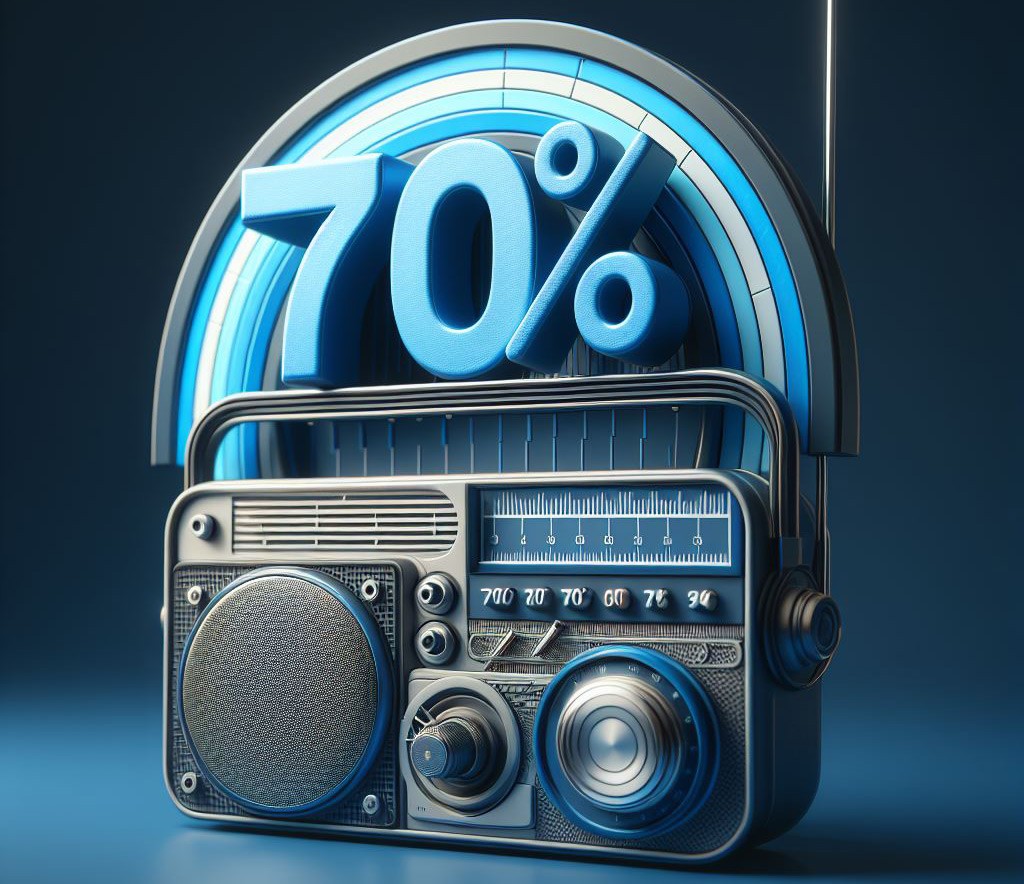Too few stations realise this
Successful Radio Stations Have a Client Retention Rate Above 90%
If it falls below 80%, they've got a problem
(This is an automated translation of the same blog post in Slovenian.)
Client Retention Rates - a Key Metric
Client Retention Rates (CRR) are one of the most important metrics for measuring the KPI (key performance indicator) of a successful business.
According to available statistics and compared to any other industry, media in general and radio stations in particular have the highest client retention rates (84%).
This means that on average, 84% of all clients who advertise on radio station continue to do so year on year. The number seems extremely high. So why even open the topic? A client retention rate between 70% and 80% is very, very successful at first glance, but for media, especially for radios, which have high personnel and energy costs and traditionally scramble with small profit margins, this data is extremely worrying, as it means that they are dependent upon this high retention rate. For radio stations, any rate below 90% can be improved upon.
Client retention rates are something every employee in management and sales at any radio station should know, as it is an important tool for client acquisition. A client who finds out their media partner has a 90% retention rate can be confident that their counterpart, the representative of the radio station, not only knows what they are talking about, but because they retain most of their partners from year to year, that their clients are happy and achieve a very good ROI – good results make for long working relationships.
This is also confirmed by an article in Rolling Stone from June 2023, where the client retention rate on radio stations is described as: “one of the best avenues for client acquisition”.
On the flip side, we have stations with low retention rates – especially those with a lower rate than 80%. These are red flags. One of the characteristics of such stations is that the sales team will constantly look for new clients. This may even appear as if they operate on a ‘scam and run’ system, despite their intentions which may very well be honourable. The vast, vast majority of radio stations do not operate this way, it is not sustainable. It is a coping mechanism for stations that are not sure how to deal with the problem, may not have the knowledge to deal with what they are facing, or perhaps do not even know what their main problem is, where to look for it, and how to find it.
What influences client retention rates?
Many factors influence client retention rates on radio stations and among the most important are: the quality of the program, the music played, stable listener statistics, and the relationships the station has with its clients (responsiveness, professionalism, flexibility, likeability, …). But regardless of how good the relationship the station has with its clients and how flexible they are, even if the station has stable or growing listener stats – if the ads on air are average or bad, it is an inevitability that clients will leave sooner or later.
Simplified:
Bad program and music scheme = bad listener stats = inability to acquire clients (not retention, acquisition)
Bad relationships with clients = bad ability to acquire & retain clients
Bad ads = bad client retention rates
Ads are also part of the sound image of the radio station and represent 10-20% of everything listeners hear on air. That is huge, and a statistic too few are aware of. The founder of the most listened to radio station in Slovenia: Radio 1 (Radio 1 instantly became the most listened to station in Slovenia and kept the rank until his departure),
Leo Oblak, told me at one of our meetings: “the dream of every radio station is ad blocks that listeners want to listen to”.
So, such good production, such quality ad blocks, that the listener is interested in what comes next. Stations spend tens of thousands of euros to improve their program and music choice through research, acquiring statistics, inviting experts to teach them from abroad, workshopping, and more…, but most often forget that ads make up a whole fifth of their program and not only deserve more investment - this investment is an absolute necessity!
Why are regular ad blocks so important?
As a ‘rule of thumb’, an average commercial radio station, whether national or regional, acquires 70% of all its revenue from regular ad blocks. And it doesn’t matter whether it’s an English, French, Czech, Polish or Slovenian station – the stats are the same, with a maximum 5% deviation.

This means that the stations are 100% dependent on revenues from regular ad blocks, while most of their focus is centred around sponsorships or content promotions, where the hosts also talk about the client brands on air. Both stations and advertisers fall into this trap. Of course it makes sense to have the option if you’re a big brand, and of course it is the most premium promotion available on air with the ability to create a huge shift in listener actions – this is also one of the clearest ways of showing how well a radio can influence its listeners, as such it has a huge place in the station’s portfolio. But the focus of the station should not be solely on this glitter, because this revenue stream alone simply cannot keep it afloat. Focus must shift to the bigger picture, the foundations upon which the glitter sits.
I have been working on radio for almost 30 years and in all this time there is only one common thread: radio works if you allow for it to run the long game. Adverts need time, on average at least 3-6 months, for their messages to come into the listeners subconscious, and to begin the process acquiring trust in the brand. For large brands, sporadic intensive campaigns can be enough for their needs (promoting new products, discounts, etc.), but with large brands, the trust has already been built. The main role of radio is to continue to keep a brand in the focus of its listeners, to build trust, and if everything is done right, there are very few cases where a client does not stay on after the first year and in these cases the reason is most often on the client’s side (where their business does not go as planned due to operational mishaps, procedural errors or simply bad luck – as an aside: luck is often cited as a key component of a successful business).
Literally: producing bad radio ads costs us money
Most radio stations make most of their ads themselves. And since we know that ads are key to the very existence of a station, you would think that none of them would contemplate their main department being a ‘fast food’ production unit. But unfortunately, the opposite is true in most cases. When we get the sales process to the point of ad production, all the grunt work has already been done, and we have already invested most of the client acquisition costs. This means our sole focus should be on retaining our client with the effectiveness of our ads. Higher retention rates mean exponentially higher profit rates, because the investment of time and money has already been made. Losing a client at this point literally means: producing bad ads will cost us money.
Conclusions
The solution is quite simple (if perhaps demanding to implement) - improve ad production.

For a radio station, especially in the age of artificial intelligence and increasing digitisation, this is even more important. Team integration and inter-departmental co-operation is something I very rarely see, and it is imperative; understanding psychological triggers and a clear sequence of communication from the client to the studio with all available best practices; teaching vocals how to be naturally flexible and naturally emotional; and to get all the raw parts of a good ad together for final production. Then all that is needed is an awareness of the sound image of the station, to fit the ads into that sound, hear where the raw sounds can perhaps be improved, or leave a ‘sound bite’ that was not initially intended to be in the commercial, but really makes it stand out – and finally, package all the elements into a product that pops.
If you are already in the process of renovating your ad production, or if you would like to do so, we at Oglasna are at your disposal. We know how difficult this process can be, and we are here to simplify it.


